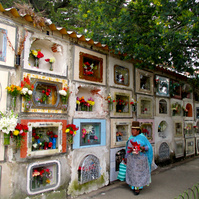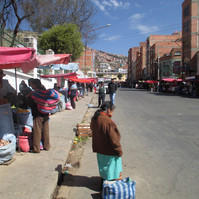Los Lustrabotas de La Paz
The shoeshiners of La Paz
I meet my tour guide on El Prado, the busiest street in Bolivia’s administrative capital, La Paz, as the city yawns and stretches into consciousness.
A small girl, hidden behind a shock of black hair, introduces herself as we navigate the early-morning rush. “I didn’t know my mother and my father used to beat me,” she explains as we clamber into a shared taxi heading for a less wealthy area. “So I left. And I started to shine shoes.”
The 22-year-old is part of Hormigon Armado, a group set up to take care of the shoe-shiners who work on every street. The organisation teaches the lustrabotas to lead tours of La Paz, to show tourists how it looks through their eyes.
Paceñas, citizens of La Paz, walk by, oblivious to wrinkled hands cupped for change and their owners desperate eyes. Traffic warden cholitas wearing bowler hats, trailing plaits and hi-vis vests which clash against the puffy layers of their traditional skirts wave weary cars down the city’s winding backstreets. Mothers lean babies on hips and tie knots over one shoulder, cradling them in patterned rainbows of heavy fabric. Students run to lectures, stray dogs seek out scraps, newspaper sellers announce their wares and minibuses tangled in traffic jams stammer into action. Sugary popcorn-like panskallas are scooped by bare fingers from giant containers into bags at every corner. Tailors hem and stitch at roadside workshops; chewing gum sales-children pester for pennies with round, open faces at traffic lights; signs advertise the salteñas (meat-filled pasties) on offer at every second sales outlet.
Amongst them all, the lustrabotas of La Paz sit; watch; wait. “Shoeshine, señor?” they ask, as confused, flip-flopped gringos wander and brogue-wearing businessmen stroll importantly past. Perched on hard, wooden toolboxes containing brushes, cloths, and polish - their survival weapons of circumstance - some chatter whilst the worst-off slump, glue-sniffing themselves into a state of semi-consciousness. Many hide behind thick, black balaclavas. They treasure anonymity; protecting reputations, covering scars and intimidating recently-arrived tourists - not with violence, but the violence their facial attire symbolises.
“There aren’t many female lustrabotas. And I’m the only one who does tours,” my tour guide tells me, a small smile of pride tickling her full lips. We suck sugary coffee through straws in plastic bags, weaving expertly as two between stalls brandishing everything from dried llama foetuses to mobile phones. I follow her through different sections of the market, down whole streets of shops devoted to a single thing; from traditional hats to bread to carnival decorations.
We reach the city cemetery and wander around. Rows of eerie, rain-worn concrete walls house hundreds of small, padlocked glass-fronted shrines in various states of disrepair.
“We used to sleep in those,” she says, pointing at a wall of vertically-stacked crypts. “We’d get drunk, take the doors off and curl up in the concrete holes. People don’t respect us. The men used to look after me, but now they look out for themselves,” she tells me.
“We all have to look out for ourselves.”




